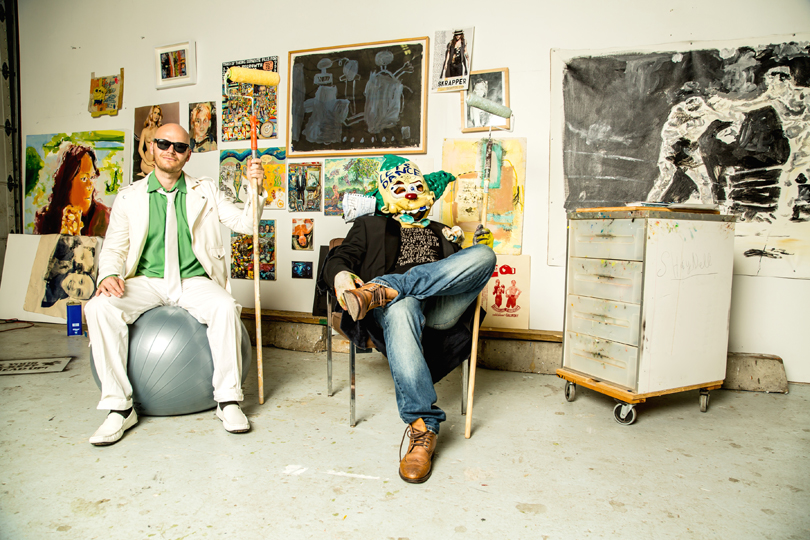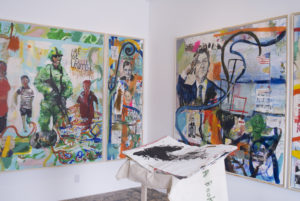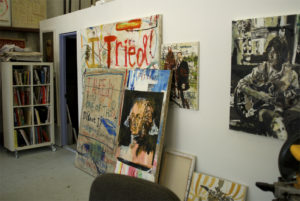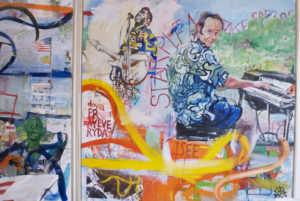AN EXIMIOUS COLLECTIVE
A personal interview about Art; Heritage, Philanthropy, Life & Humility
American artist, William Quigley burst onto the scene in 1985 with a breathtaking sold out exhibition that was showcased with the ecclesiastic of Pop Art, Andy Warhol. Since that time, Quigley has been coined the “Cultural Catalyst” of our generation. His artistic éclat is coveted by collectors worldwide and celebrated by his peers for composition of light and color, evoking emotional responses and drawing the viewer into a piece with rhythmic precision. Quigley’s technical ingenuity is comparative to a diversity of symphonic expression. From his soulful portraits to serene landscapes, abstract intensities and the “vulgar beauty” of his socio-political anti-racial and anti-crime statements, he captures each canvas with sensitivity. William combines his passions of art with his strong sense of nationalism throughout his narrative in an inspiring and tantalizing demonstrative.
OTI: Many artists find a genre and stick to it. As an artist, you perpetually fluctuate between realism and abstractionism, both magnificently and seamlessly. What are your feelings on your ability to master so many types of expression?
WQ: I’ve been painting and making a living off my work since 1985. In that time, I have watched not only my world, but “THE WORLD”, change drastically as far as attention spans go. I started painting long before the internet or cell phones. Art, and art making, has changed along with technology. It seems today one does not have to really paint so much to get a statement or message across. In a world filled with fast -paced moving imagery, data, and information made readily available, I still love the challenge of using paint, primarily oil, to convey my thoughts. I think it’s more of a science and magic trick now more than it was before. I still get excited over Vermeer, Rembrandt, Van Gogh, Picasso, Gorky, Alice Neel, Francis Bacon, Courbet, Guston, Willem de Kooning and even my close friend Marc Chiat- The way they attacked their canvases and painted out their thoughts. I love learning about new artists like Miriam Schapiro and the vast body of serious imagery she has tackled and Clyfford Still. The commercial aspect of art, I think comes much later for most serious artists. Look at Bacon- Not many people were buying his canvases, or even Pollock, for that matter. Now what? $40 million? $20 million? etc. (quigleyart.net in “Available works: Karl Hutter Gallery and Abstraction”)
I think about other artists work a lot, which leads to a new vocabulary in my own pursuits. Schnabel, Kippenberger, Luc Tuymans… so many. I was using icons like Christopher Columbus and James Watt as metaphors with their biographies written right on the surface like a child in the paintings to show a new found fearless portrayal, reflecting our natural lack of patience for process. I kind of think the reason Basquiat gets so much attention, besides the art world stamp of approval, is not because of the money invested, but because of his rawness at a time when the art world was a bit stoic. Graffiti was all over the walls, subway cars, bars, and canvases in the 80s. It was punk rock influenced. Yet, he broke free because of his desperation to hustle and sell his work. People don’t get that about him. He was constantly selling and aware of whom he was targeting. I think all these factors play into what type of art one makes, and how much information affects its complexity, content and outcome.
Since I started painting, I have been incorporating figures on, over, and under the abstraction. Kline, Willem de Kooning, Miles Davis, Oscar Peterson, Guston and the old school work from the 1950s is something that always gets me excited. I like to think I’m trying to keep the chain going. Plus, look at Picasso or Michelangelo or Leonardo da Vinci. And we haven’t even started talking about the influence medicine and science has had on the paintings, Lol.
 OTI: Simply put, what is your muse? What in life drives you to create? Is it a moment that you try to encapsulate? Regarding your portraits, since you paint both the famous and completely unknown, what is the particular quirk or character trait of a person that stimulates you?
OTI: Simply put, what is your muse? What in life drives you to create? Is it a moment that you try to encapsulate? Regarding your portraits, since you paint both the famous and completely unknown, what is the particular quirk or character trait of a person that stimulates you?
WQ: I’m not married. Wanting the normal life has always been a factor or maybe striving to pretend painting and making a living at it can be considered, “Normal”. I dislike the preconceived notion that if you’re an artist, you probably can’t make a living. My goal has always been to go way beyond that theory. I assume Picasso had this incredible confidence in his ability to work hard and make a living, which probably drove him to work as much as he could. I try to look at what I do as a job. My brothers- in- law, brother… all of them actually work exceedingly hard. One is a global insurance guy who travels nearly 5 months a year away from his family. My brother, Michael, works constantly in his auto parts business. My other brother- in- law is a brain surgeon at Harvard. My mother “busted her ass” to raise 4 children. I kind of see what I do as kind of lucky, but never once have I tried to take it for granted. As far as the portraits, since I was very young, 5 maybe; I was drawing cartoons which are all about the facial expression and identity of each character. I never really painted until I went to college. I was at the age of 19 or so, when I made my first painting. It was a copy of Raphael’s “Madonna of the Chair” for a Christmas present for my mother. It took forever because I was using small brushes. When I went to College, I saw all these students carrying giant canvases. Then I went to Rome to study at Tyler School of Art and the world changed. Caravaggio, Da Vinci, Michelangelo, Brunelleschi, Botticelli, Bellini, Durer, Giotto, Titian, Giacometti, the Spanish steps.
That was it! The Italian portraits combined with my knowledge of Norman Rockwell and Charles Schultz made me want more. I really don’t consider myself good. I’m always thinking of the next paintings. There are so many great artists, both historically and now, that I look at my own work as “always trying to get better”. Goya, Rembrandt, Picasso, David Velázquez, even Alice Neel, Bellini, Matisse, David Hockney… they are the reasons I paint portraits. I love Jenny Saville. She is an incredible painter, as well as Cecily Brown, Sean Landers (both of whom I went to school with). I always love getting excited by others work. – George Condo. With all this in my head, I’m always complimented when someone asks me to paint them, or paint someone for them. I’m so focused on making a good painting that is original, and having the painting look like the individual I’m tackling. It’s the one stimulant that continues to haunt me or maybe conversely, that I feel good about down deep.
Perhaps, it was in 1985 that I painted Lincoln. I was subtlety criticized for painting celebrities like Arnold Schwarzenegger, Muhammad Ali and Audrey Hepburn quite a few times back in the early 90s. I even remember one high end NY dealer saying Arnold is not a collector, and painting these portraits is very commercial. After painting Arnold, I looked for other people that were not so much in the “art” limelight like SHAQ. I think I sold him his first paintings. I’d say that purchase made my career in some sense. Shaq is the greatest guy, and over time has become a giant art buyer and enthusiast. He even did a show called “Size Matters” at the prestigious Flag Foundation in Chelsea (flagartfoundation.org), with his collection “Size matters- Shaquille O’Neal.”
As far as all the other portraits and the criticisms surrounding them, it seems every young street artist now is painting Ali, Audrey, Lincoln etc. I wonder if they even know who I am? To keep things “honest” I recently painted Paul Giamatti for a lot of reasons, but mainly because no one else has. On the mini- screen, he depicts John Adams, a character, again, I wish to portray in my own work as a metaphoric icon for a “Lost America moving in different directions,” which is now kind of evident by the current election.
 OTI: You have a deep interest in the civil war and conveying the complexities that are not usually taught, seen or understood by the masses. Voices the world over are unified in belief that there is no social justice without economic empowerment or forward progression. For centuries, artists have understood the power of art as a tool for social commentary. It would seem natural, then, for modern activists to use art as a weapon to fight for just causes. Is there something within today’s society that you wish to expose directly or indirectly through your art?
OTI: You have a deep interest in the civil war and conveying the complexities that are not usually taught, seen or understood by the masses. Voices the world over are unified in belief that there is no social justice without economic empowerment or forward progression. For centuries, artists have understood the power of art as a tool for social commentary. It would seem natural, then, for modern activists to use art as a weapon to fight for just causes. Is there something within today’s society that you wish to expose directly or indirectly through your art?
WQ: In 1996 living in LA, I started painting about the Civil War after Spike Lee’s films “Malcom X” and “Crooklyn” came out. In 1991-92 we had the LA riots. I was right there, outside my studio. After living in NY, and feeling all this pressure from crime, racism, (which I detest), etc. … I thought it may be appropriate to compare what was going on in the US now to what happened during the Civil War. Every night on the 11 o’clock news in any given US city there would be countless crimes committed. I used this as motivation to study what really happened in the 1850s and 60s leading up to the Civil War, less than 100 years after fighting so hard for Independence. I kind of think painters don’t take enough of a risk in their work to speak out or use it as a voice. A lot of artists hide behind the esoteric wall of aesthetic theory. Theory is as important as having a unique voice. Studying from great minimalists, Agnes Martin and Mark Rothko, I incorporate captivating content that allows one to digest what the painting is about. I look at my paintings as a novel with messages – deepening the artistic elements in the canvas on how they are created and processed.
Ironically enough, my last show in 1996 with Karl Hutter in LA, was all about tradition; nostalgia, the election, and the direction I thought the US was headed. It’s a 32 ft. painting, the same size as Picasso’s Guernica, with a very political message specifically about the US. It ends with a portrait of one of my best friends, the late acclaimed jazz pianist genius Paul Tillotson, with whom I painted in March/ April 2016 before his passing on June 17th after a long battle with colon cancer. Paul was a symbol for “ART, MUSIC, how important health, friends and family are, and great memories.” No matter what your politics, LIFE is what matters. How you live it, what you do with your time and what you leave behind. Paul had over 1300 people at his funeral in Sun Valley. There were another 1000 at a celebration in NYC on Nov 1st. He was so, so, so giving. This is why I paint; to meet talent like that.
Simply because you are passionate about your own quest, there is nothing that seems more precious than great friends to share it with. A collector is simply a new friend who likes what you do and wants to live and enjoy it. I get chills every time someone new buys my work. Besides making the paintings, selling them is the greatest thrill. I sold the painting of Paul to one of his dear friends, Lou Hansell, AKA “Liquid Lou”. Paul called him for $65,000. Due to the sale, I was able to donate $50,000 to my dear friend’s High School Scholarship Foundation which will keep the dream alive for young aspiring students in Boise Idaho. Hopefully the foundation grows like Elton John’s foundation has.
 OTI: Many abstract artists leave the interpretation to the viewer even though your message is clear while creating. Why have you taken this uncharted route, and do you wish to change the attitude of the viewer?
OTI: Many abstract artists leave the interpretation to the viewer even though your message is clear while creating. Why have you taken this uncharted route, and do you wish to change the attitude of the viewer?
WQ: I strive to be original over all else.
OTI: When did you find comfort in your work? Describe your journey.
WQ: I started painting in 1985. My first shows were with Warhol. Next with Jean-Michel Basquiat, Julian Schnabel, Pat Steir and David Salle. Then, there was Robert Rauschenberg in the 90s and Willem de Kooning in 1991. I lived at the Miro foundation.
I’m never comfortable. Like, Woody Allen says, “Not sure in my lifetime I’ll ever be able to complete all is in my head”. I just decided early that if I was going to struggle, it would not be working for someone else. I was moving furniture and art, directing movies and music videos. I worked with Madonna, Prince, David Fincher, Tom Petty, Outkast and that was not enough. I never felt attached to that work. It was a great experience, great meeting all these people…but I used to think if I work hard maybe I can be recognized for what I do, like they are. I learned a lot of tricks, and how so many people go into creating an image, a presence, like Madonna. Yes, “MADONNA”. You can’t do it alone. Painting is a different world though. Ironically enough, when you speak with actors or musicians that are known they are so interested and excited to “talk art”. Picasso or Edward Hopper? They don’t want to hear how much you liked them in some movie. Now, I find so many asking me about my work. I’m always put off guard like they really don’t care. But they do. My own family, with the exception of my mother, really doesn’t see public notoriety or the value in it. I may mention that I’m friends with a certain actor or “whoever”, and my sisters keep saying that I’m dropping names or “come on” etc. But after living in LA and NYC for 30 years you are going to meet a lot of people who buy art seriously and are very interested in the “other art.” WE are not writers. There is a certain mystery and allure surrounding the market, the hype and success. And then, if you think about it – How many people are going to museums daily when they travel to Europe, or almost anywhere in the world?
OTI: At your core, you are a philanthropist. What drives your desire to give to your chosen causes?
WQ : I donate to as many charities as I can. Edwin Gould Services for Children and Families(egscf.org), Guild Hall(guildhall.org), Children’s Museum of the Arts(cmany.org), Wounded Warrior Project(woundedwarriorproject.org), Soldier Ride(welcometosoldierride.com), B4BC/Boarding for Breast Cancer( b4bc.org), and Seeds of Africa(seedsofafrica.org).
OTI: Your use of color, form, frame and light reflection evokes mood with sensitivity to the subject matter, especially in your black and white portraits. (i.e. Audrey Hepburn-there’s a palatable softness to this piece) What is your preferred media? (Oil, pastels, oil crayons, acrylic)
WQ: Oil and framing the work is very important to its sculptural quality, like Piet Mondrian or Joseph Cornell.
OTI: Define what human luxury means to you?
WQ: Luxury, to me, means having the ability to pay my bills. It’s the ability to give money to my mother. It’s paying my taxes. It’s having white canvases ready when I come to the studio. It’s having them framed and then shipped by the buyer. Maybe a fun car to go around in and traveling to foreign lands so I can visit galleries that want to show my work. I do like red wine… and bikinis……lol .
OTI: Can u share your passions of other mediums? Fashion, art collecting?
WQ: I collect art pretty passionately. However, I also love film, books (I have a pretty serious collection of books, especially Taschen), baseball cards and art. We are working on a documentary with Vice Television Director, Dominic Musacchio and Producer Brian Sullivan for 3 years about my career. Kind of like a “House of style for Art” called NOT QUITE THERE.
OTI: What other exciting ventures are you working on? There’s talk of a new book…
WQ: Yes, we are trying to publish the first large table top book. I’m very excited by this.[/vc_column_text][/vc_column][/vc_row]












